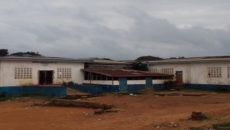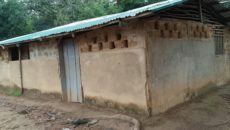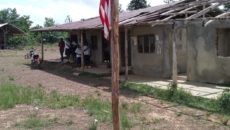On January 22, 2018, Senator George Manneh Weah was sworn in as president of Liberia. This represents the first democratic transition in about three-quarters of a century. Weah won 62 percent of the votes in the presidential run-off against his opponent, former Vice President Joseph N. Boakai of then ruling Unity Party – a victory many political pundits have hailed as the people’s quest for change.
On the day of the official announcement of the results of the presidential runoff elections, thousands of young people took to the streets chanting, “Degree holders, you know book and [yet] we in the mansion.â€
The chants were responding to the prevalent narrative surrounding Weah’s quest for the presidency – that he lacked the education and experience to be president. Although Weah now holds a master’s degree, education has long been a popular argument against his run for the presidency.
In 2005, when Weah first ran against Ellen Johnson Sirleaf, critics saw the former football star as unqualified against his Harvard educated opponent. Few public speaking engagements and limited commentary on national issues, especially as a senator, increased the profiling that he was unprepared. Now as president of Liberia, Weah’s leadership will once again face the question of education.
Over the last twelve years, recovery and reconstruction efforts prioritized securing peace and improving the economic infrastructure of the country. For education, the outgoing government targeted strengthening the education policy framework with key legislation (i.e., Education Act 2011), the establishment of county school systems, increasing the number of schools and building the capacity of teachers.
However, access to quality education has been limited. A variety of factors, including insufficient and unqualified teachers, limited access to early childhood education programs, inadequate learning and instructional materials, as well as poor water and sanitation facilities affect public schools across the country.
Liberia also has the highest rate of out-of-school children with 62 percent of children out of primary school.  In addition, many students are ‘at-risk’ of dropping out of school, including students of low income households, overage students, children with disabilities and those affected by one or a combination of factors such as poor teacher attendance, overcrowding, sexual violence or the long commute to schools (45 minutes or more). Girls, in particular, are at higher risk due to cultural norms and harmful traditional practices such as female genital mutilation and early marriage.
In 2013, a massive failure of 25,000 students for entrance exams for the national university-led former President Ellen Johnson Sirleaf to declare the education system “a mess†and heightened calls to reform the education system. The 2014 Ebola outbreak further affected the education system with the closure of schools for six months.
In January 2016, Liberia embarked on a public-private partnership with the controversial for-profit multinational organization, Bridge International Academies, to manage 50 public schools in a six-month pilot and all primary schools in five years (estimated to cost US$93 million overall). It was aggressively promoted as a bold, innovative, and revolutionary solution to improve learning outcomes and address the poor quality of education in Liberia.
Following backlash over this unprecedented attempt to privatize education, the ministry expanded the program to seven additional providers under a rebranded program, Partnership Schools for Liberia. Under PSL, Bridge and other providers managed 93 schools, representing barely three percent of public schools. PSL schools received US$50 per student and US$50 additional via a grant made by a consortium of foundations and philanthropies.
Providers were free to find additional funds on their own. The total costs for the current pilot are unknown but reportedly ranging from a minimum of US$50 and as high as US$1,100 (Bridge) per student. Only two of the eight providers are owned and managed by Liberians. In August 2017, the program was scaled up to additional 100 (totaling only 10 percent of public schools). Bridge, with major backing by private philanthropists, venture capitalists, and the World Bank’s International Finance Commission, is the single largest provider running 68 schools (25 in Year 1 and 43 in year 2).
The case for PSL expansion is anchored to the historical neglect by the state to fulfill its role in funding quality education for all Liberians. While the civil war affected the education infrastructure, public schools, especially outside of Monrovia and few cities, had been left derelict for decades. This is anchored in the socio-economic policies related to Liberia’s political governance which saw over 100 years of leadership of Americo-Liberians and a concentration of resources, power, and access to the capital and urban areas where they lived.
Although Liberia was declared a Republic in 1847, indigenous Liberians were not included as citizens until 1904 and their voting rights obtained in 1946 were contingent on property ownership and literacy in English, qualifications that effectively excluded a majority of the population. Rural populations primarily depended on charities and or faith-based organizations as the duty bearers.
In some rural communities, parents pooled resources to build schools (eventually turned over to the state to support) or to fund additional teachers as volunteers. Volunteer teachers now represent 26 percent of the teaching workforce and are uncompensated by the state.
Classrooms held 75-100 students and schools hosted six classes in a four-room structure or in makeshift learning structures under trees. Poor banking and road infrastructure accounted for 36 percent of the absence of teachers on the government payroll as many had to travel for days to receive their salaries. Post-war recovery, Liberia was spending barely 3 percent of GDP on education (against a recommended international benchmark of 6 percent).
So, while countries like Liberia required a better educated, prepared and healthier workforce, governments ended up spending less on these sectors and more on infrastructure supposedly to attract big businesses – that would eventually require the very same workforce.
Public-private partnerships can look very attractive for developing countries like Liberia which are caught in the web of limited revenues and the increased demands from their growing populations. Liberia’s budget was US$564 million in 2017, of which US$298 million (53 percent) went towards salaries and administration while only 11 percent went to health and 14.6 percent to education.
The argument seems easy. ‘Poor’ countries cannot afford to provide education. So with a public-private partnership, private companies offer education at a low fee, and the costs are subsidized by contracts, direct payments by parents, or grants.
However, these arrangements have yet to demonstrate that they can ensure equality and equity in access and efficiently deliver quality education. This was reinforced by an independent evaluation commissioned by the ministry for the PSL program, which raised serious concerns regarding the sustainability of the program and its ability to deliver, especially in the most disadvantaged schools.
While the report from the randomized controlled trial (released in September 2017) showed minor gains in some PSL schools, mostly in addressing absenteeism of teachers and an average of 35 percent more in Math and English, it also led to high dropout rate and overcrowding of nearby schools due to capped class size.
Gains touted by PSL were based on preselected urban and accessible schools (including internet connectivity), pre-screened teachers and students (low performing ones were sent away), smaller class sizes and increased school hours (up to 4 p.m. in some schools). The authors of the report also strongly cautioned against an expansion.
President Weah has repeatedly stated his commitment to supporting pro-poor policies and equality, including free education. Liberia’s education law provides for free and compulsory primary education. The national development strategy, the Agenda for Transformation, and the recently finalized Education Sector Plan (Getting to Best 2017-2021), have commitments to education and some promising initiatives to address the education system.
It is unclear if Weah’s government will consider these two or develop a new agenda for on delivering pro-poor policies. Inheriting a government already experiencing a decline in revenues, it would be untenable for the government to continue to support PSL or scale up to the remaining 90 percent (even with private philanthropy).
Gains have been minimal, and at the current costs, this means the majority of children across the country will continue to go to poorly funded and under-resourced schools, creating tiered access to education. This will have a long-term adverse impact on the country’s current socio-economic gaps in a country with the already high level of inequality. It is therefore urgent that the new government commits to the cessation of the PSL program and instead, increase budgetary support to all public schools.
Reduction of wasteful spending is an immediate step towards increasing funding. Liberia’s annual budget covers incentives such as fuel and communication cards, and high vehicle and travel costs (including business class tickets, daily sustenance allowance, and incidentals). There are also funds earmarked as “special projects,†“grants,†and “subsidies.â€
In the Ministry of Education’s budget alone, some faith-based and private institutions receive subsidies. In 2017, the overall budget was US$1.7 million for subsidies and US$583,000 for grants. The amount per school is not fixed or consistent, and it’s not clear what these subsidies or grants cover since students still incur costs to attend these institutions. Funding from these cuts can be re-allocated to education, bringing much needed immediate relief to the education system and a number of children impacted. Nonetheless, austerity measures can only provide quick and short-term support to education, and they do not address the long-term sustainability of the education system.
Increased public financing is critical to begin to address the under-resourcing of the public school system. This requires more revenues. Taxes (income, property, and goods and services) makes up 70 percent of the country’s annual source of revenue. However, Liberia provides a variety of tax breaks to incentivize multinational companies’ investment in Liberia due to the country’s limited infrastructure (energy, roads, etc.).
Companies receive between 5-25 years’ of tax break (Firestone Rubber Plantation had 99 years) and in return, are supposed to make economic, social, and environmental commitments such as infrastructure development (roads, housing, etc.), provision of schools and scholarships or an annual funding obligation, ranging between US$1-3 million towards.
Even the International Monetary Fund deems most of these to be harmful tax incentives which no country should need to provide to attract investment. The total value of some of these agreements is merely an average of US$75 million over those 25 years – a small fraction of the tax that they have avoided. Some companies have yet to fulfill their commitments, often citing the low market value of the mineral being extracted (which is all too easily manipulated to look lower than it is).
In a struggling economy, these tax breaks are giving away desperately needed revenues that the government can use to invest in the education system. This is unfortunately not unique to Liberia. The IMF estimates that developing countries combined are losing over US$200 billion annually.
Extensive work has been done locally and globally on progressive tax system reforms that the new government can review and consider including the ongoing Organisation for Economic Co-operation and Development tax policy review (Liberia’s scheduled in March 2018) and reversing some of the tax breaks.
More than half of the voters chose Weah in the presidential run-off. For them, Weah’s presidency means change. There is a critical need to shift socio-economic policies and increase redistribution of wealth and resources for the majority of families living in poverty in Liberia. About 65 percent of the population of 4.5 million lives on US$1.50 per day and about 60 percent is under age 35.
Many Liberian youths have no formal job training and no livelihood source of their own. President Weah’s rags-to-riches story has been an inspiration for many young women and men across the country. His success is due to pure talent, hard work and opportunities. In urban slums and rural communities, similar to where President Weah grew up, public schools are churning out young women and men eager to attain at least a portion of such success.
Centering education as a pivotal socio-economic policy can address the socio-economic disparities in the country by improving the quality of education and access for all Liberians. This will need to start with the basics – increasing budgetary support and financing for the whole public education system. Rather than a case for private sector management, what PSL demonstrates is that by better funding public schools and investing in trained teachers, regular salaries, and learning materials, children can learn better. As president, Weah has the crucial opportunity to deliver quality education as an equal and accessible right for all Liberians and thereby, ensure equitable, inclusive and sustainable development for all Liberia. The ball is in his corner.



